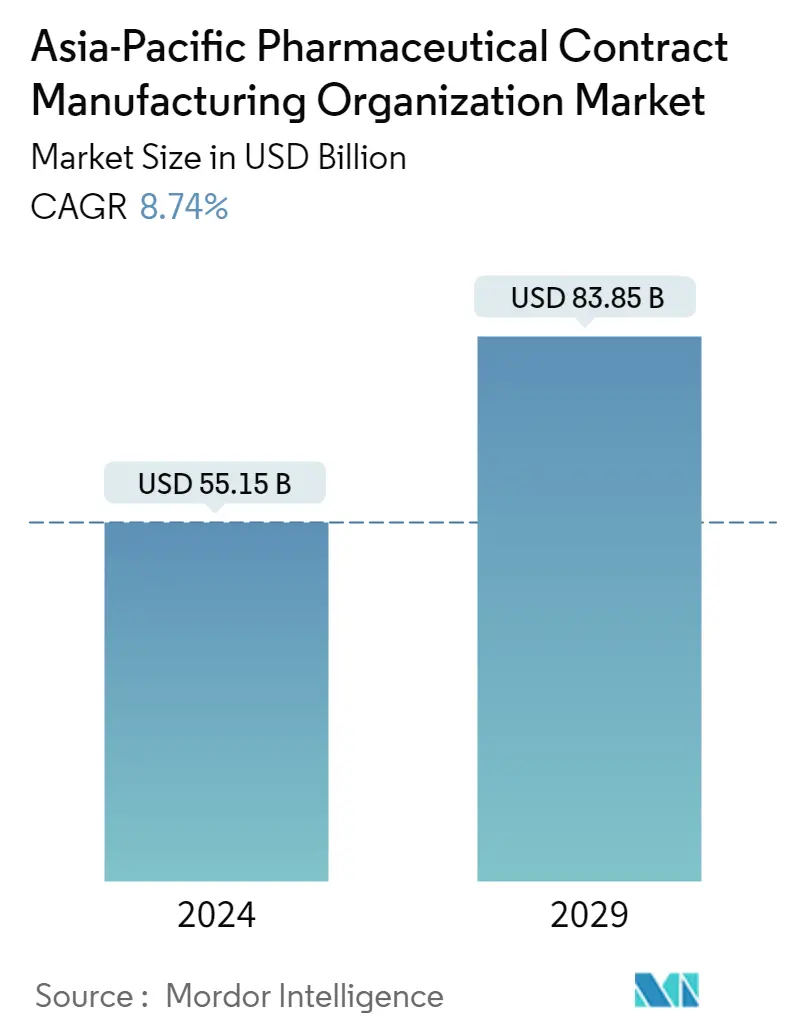Market Size of Asia-Pacific Pharmaceutical Contract Manufacturing Organization Industry

| Study Period | 2019 - 2029 |
| Base Year For Estimation | 2023 |
| Market Size (2024) | USD 55.15 Billion |
| Market Size (2029) | USD 83.85 Billion |
| CAGR (2024 - 2029) | 8.74 % |
| Market Concentration | Low |
Major Players
*Disclaimer: Major Players sorted in no particular order |
APAC Pharmaceutical Contract Manufacturing Market Analysis
The Asia-Pacific Pharmaceutical Contract Manufacturing Organization Market size is estimated at USD 55.15 billion in 2024, and is expected to reach USD 83.85 billion by 2029, growing at a CAGR of 8.74% during the forecast period (2024-2029).
China is a country with low labor wages, which alone can lower the manufacturing costs of the pharmaceutical companies by as much as 30%. Along with it, low capital and overhead costs (compared to that of the United States and Europe), tax incentives, and undervalued currency combine to provide a significant cost advantage for pharmaceutical companies outsourcing to China.
- Another factor driving the pharmaceutical CMO market in China is the country's Western-trained skilled workers. Majority of the workers who are trained in Western countries return to China to find work because of strict immigration policies an d significant unemployment among the European and American pharmaceutical workers.
- India is also taking advantage of the growth in the domestic CMO market, encouraging the Japanese pharmaceutical industries to setup their locations in the country, either wholly owned or in partnership with Indian companies.Additionally, India has until now allowed 100% FDI through the automatic route. This 100% FDI under the automatic route has been allowed in contract manufacturing to give a big boost to domestic manufacturing.
- The CMO market in Japan is still immature. However, the country witnessed incremental growth over the past few years. The Japanese CMO market witnessed a growth of about 30%, following the recognition to separate manufacturing and sales by the Pharmaceutical Affairs Act. The growth trend has been continuing ever since. The number of CMO manufacturers of significant size in Japan is low and includes players, like Bushu Pharmaceuticals, Nipro Pharma, and CMIC.
- With extensive governmental reforms in drug pricing, structural changes, and unpredictability in reimbursement and pricing decisions, many pharmaceutical companies in Australia are being challenged. However, the country is geographically well-placed in relation to pharmaceutical exports, owing to its proximity to the emerging markets of South Asia.
- The recent medical outbreak of COVID-19 has its epicenter in Wuhan, a Chinese city that was once known for its heavy industry and steel and was poised to become a burgeoning center for bio- pharmaceutical manufacturing. Such outbreaks may lead to the disruption of drug supply and manufacturers are required to notify the US Food and Drug Administration when that happens. As the outbreak becomes more widespread, it becomes a burden for pharmaceutical plants around the world to maintain the inventory required for manufacturing, as China is a major supplier of raw materials.
APAC Pharmaceutical Contract Manufacturing Industry Segmentation
Contract manufacturing is a form of outsourcing where a manufacturer enters a formal agreement with another manufacturing firm for its parts, products, or components. The former manufacturer uses these in its own manufacturing process for manufacturing its products. The scope of the market is comprehensive and is limited to Asia-Pacific.
| Service Type | |||||
| |||||
| |||||
| Secondary Packaging |
| Country | |
| China | |
| India | |
| Japan | |
| Australia | |
| Rest of Asia-Pacific |
Asia-Pacific Pharmaceutical Contract Manufacturing Organization Market Size Summary
The Asia-Pacific pharmaceutical contract development and manufacturing organization (CDMO) market is experiencing significant growth, driven by factors such as cost advantages, skilled workforce, and strategic partnerships. China and India are at the forefront of this expansion, with China benefiting from low labor costs, tax incentives, and a Western-trained workforce, making it an attractive destination for pharmaceutical outsourcing. India is also capitalizing on this trend by encouraging foreign investments and partnerships, particularly with Japanese pharmaceutical companies, to boost its domestic manufacturing capabilities. Despite challenges in countries like Australia due to regulatory reforms, the region's strategic location and growing demand for injectable drugs, especially in oncology, are contributing to the market's upward trajectory.
The market is characterized by a shift towards outsourcing, as large pharmaceutical companies seek to reduce production costs and time to market while leveraging specialized expertise from CMOs. This trend is leading to increased competition among vendors, who are expanding their operations and forming strategic collaborations to enhance their market presence. The COVID-19 pandemic has highlighted the region's dependency on China for key pharmaceutical ingredients, impacting supply chains and manufacturing costs. However, the market continues to evolve, with significant developments such as capacity expansions and new facility constructions in countries like India and China, further solidifying the Asia-Pacific region's role in the global pharmaceutical manufacturing landscape.
Asia-Pacific Pharmaceutical Contract Manufacturing Organization Market Size - Table of Contents
-
1. MARKET DYNAMICS
-
1.1 Market Overview
-
1.2 Industry Attractiveness - Porter's Five Forces Analysis
-
1.2.1 Bargaining Power of Suppliers
-
1.2.2 Bargaining Power of Consumers
-
1.2.3 Threat of New Entrants
-
1.2.4 Intensity of Competitive Rivalry
-
1.2.5 Threat of Substitutes
-
1.2.6
-
-
1.3 Industry Value Chain Analysis
-
1.4 Industry Policies
-
1.5 Market Drivers
-
1.5.1 Increasing Outsourcing Volume by Pharmaceutical Companies
-
-
1.6 Market Restraints
-
1.6.1 Increasing Lead Time and Logistics Costs
-
1.6.2 Stringent Regulatory Requirements
-
1.6.3 Capacity Utilization Issues Affecting the Profitability of CMOs
-
-
1.7 Assessment of Impact of COVID-19 on the market
-
-
2. MARKET SEGMENTATION
-
2.1 Service Type
-
2.1.1 Active Pharmaceutical Ingredient (API) Manufacturing
-
2.1.1.1 Small Molecule
-
2.1.1.2 Large Molecule
-
2.1.1.3 High Potency API (HPAPI)
-
-
2.1.2 Finished Dosage Formulation (FDF) Development and Manufacturing
-
2.1.2.1 Solid Dose Formulation
-
2.1.2.2 Liquid Dose Formulation
-
2.1.2.3 Injectable Dose Formulation
-
-
2.1.3 Secondary Packaging
-
-
2.2 Country
-
2.2.1 China
-
2.2.2 India
-
2.2.3 Japan
-
2.2.4 Australia
-
2.2.5 Rest of Asia-Pacific
-
-
Asia-Pacific Pharmaceutical Contract Manufacturing Organization Market Size FAQs
How big is the Asia-Pacific Pharmaceutical Contract Manufacturing Organization Market?
The Asia-Pacific Pharmaceutical Contract Manufacturing Organization Market size is expected to reach USD 55.15 billion in 2024 and grow at a CAGR of 8.74% to reach USD 83.85 billion by 2029.
What is the current Asia-Pacific Pharmaceutical Contract Manufacturing Organization Market size?
In 2024, the Asia-Pacific Pharmaceutical Contract Manufacturing Organization Market size is expected to reach USD 55.15 billion.

